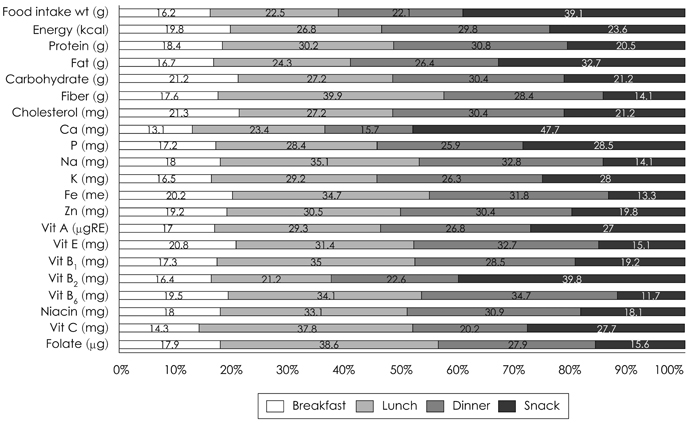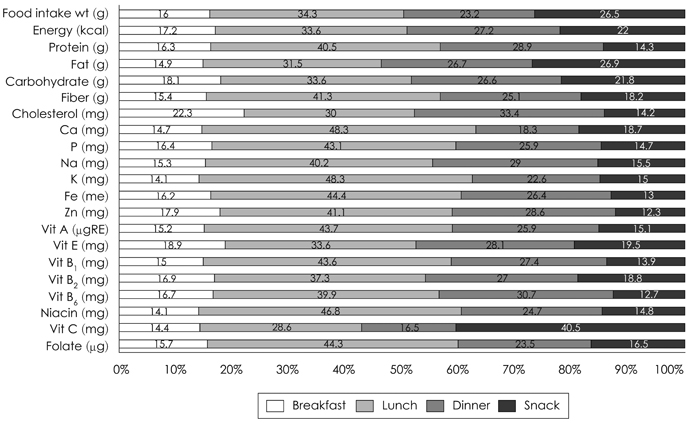J Nutr Health.
2014 Feb;47(1):51-66.
A study of the major dish group, food group and meal contributing to sodium and nutrient intake in Jeju elementary and middle school students
- Affiliations
-
- 1Department of Food Science and Nutrition, Jeju National University, Jeju 690-756, Korea. yangsook@jejunu.ac.kr
Abstract
- PURPOSE
The objective of this study was to investigate the differences of sodium intake in the diet according to the kind of meal, food group, and dish group.
METHODS
A dietary survey was conducted using the 24-hour recall method from April to May, 2009. The study subjects consisted of 701 elementary and 1,184 middle school students in the Jeju area. Mean sodium intake and the percentage contribution of meals and each dish and food group to daily sodium intake were calculated.
RESULTS
The daily sodium intake was 2,868.4 mg and 3,032.5 mg in elementary and middle school students. For elementary school students, breakfast, lunch, dinner, and snack provided approximately 18.0%, 35.1%, 32.8%, and 14.1% of total daily sodium intake, and for middle school students, 15.3%, 40.2%, 29.1%, and 15.5%, respectively. Major food groups for sodium intake were spices (1,252.5 mg in elementary, 1158.0 mg in middle school students), vegetables and their products (409.0 mg, 495.6 mg), cereal and grain products (322.4 mg, 647.8 mg), and fish and shellfish (255.3 mg, 336.6 mg). Except cereal and grain products, sodium intake of the food groups mentioned above was greater at lunch and dinner than at breakfast and snack. And, the elementary and middle school students obtained 5.9% and 9.8% of total daily sodium intake from cereal and grain products at snack. Among the 29 dish groups, the highest dish groups contributing to dietary sodium intake were soup and stew and tang/jeongol, consuming 19.8% (elementary school students) and 25.4% (middle school students) of daily sodium intake. The following major dish groups contributing to dietary sodium intake, in order, were kimchi, seasoned vegetables, grilled dish, stir-fried dish, and a la carte. By meals, the percentage of sodium intake from soup, kimchi, stew, fried dish, and stir-fried dish at school lunch was high, from noodles, grilled dish, and a la carte at dinner, and from bakery/snacks and noodles at snack.
CONCLUSION
Sodium intake from the various side dishes at school lunch was high and noodles and bakery/snacks were popular snack foods in elementary and middle school students in Jeju area. In order to lower the intake of sodium, students need to be educated about eating less soup and choosing better snacks.
Keyword
MeSH Terms
Figure
Reference
-
1. Ministry of Health and Welfare. Korea Centers for Disease Control and Prevention. 1998 Korea National Health and Nutrition Examination Survey; 2001 National Health and Nutrition Survey; The Third Korea National Health and Nutrition Examination Survey (KNHANES III), 2005. Cheongwon: Korea Centers for Disease Control and Prevention;1999-2006.2. Kim G, Lee H. The effect of lifestyle, dietary habit, food preference and eating frequency on sweet taste sensitivity and preference of the middle school students. Korean J Nutr. 2007; 40(6):531–541.3. The Korean Nutrition Society. Dietary references intakes for Koreans. Seoul: The Korean Nutrition Society;2005.4. Son SM, Park YS, Lim HJ, Kim SB, Jeong YS. Sodium intakes of Korean adults with 24-hour urine analysis and dish frequency questionnaire and comparison of sodium intakes according to the regional area and dish group. Korean J Community Nutr. 2007; 12(5):545–558.5. Contreras RJ. Salt taste and disease. Am J Clin Nutr. 1978; 31(6):1088–1097.
Article6. Kim YS, Paik HY. Measurement of Na intake in Korean adult females. Korean J Nutr. 1987; 20(5):341–349.7. Ministry of Health and Welfare. Korea Centers for Disease Control and Prevention. Korea Health Statistics 2009: Korea National Health and Nutrition Examination Survey (KNHANES IV-3). Cheongwon: Korea Centers for Disease Control and Prevention;2010.8. Elliott P, Stamler J, Nichols R, Dyer AR, Stamler R, Kesteloot H, Marmot M. Intersalt Cooperative Research Group. Intersalt revisited: further analyses of 24 hour sodium excretion and blood pressure within and across populations. BMJ. 1996; 312(7041):1249–1253.
Article9. Cook NR, Cohen J, Hebert PR, Taylor JO, Hennekens CH. Implications of small reductions in diastolic blood pressure for primary prevention. Arch Intern Med. 1995; 155(7):701–709.
Article10. Strazzullo P, D'Elia L, Kandala NB, Cappuccio FP. Salt intake, stroke, and cardiovascular disease: meta-analysis of prospective studies. BMJ. 2009; 339:b4567.
Article11. He FJ, MacGregor GA. A comprehensive review on salt and health and current experience of worldwide salt reduction programmes. J Hum Hypertens. 2009; 23(6):363–384.
Article12. Ministery of Health, Welfare and Family Affairs. The plan for low salt intake project of Korean people. Seoul: Ministery of Health, Welfare and Family Affairs;2005.13. Oh SJ. A comparative study of dietary behaviors of obese children and normal children in high grade students of elementary school in Jeju [dissertation]. Jeju: Cheju National University;2007.14. Yang BM. The food and water consumption condition of the preschool children in Jeju by duplicated food collection [dissertation]. Jeju: Cheju National University;2004.15. Yon M, Lee Y, Kim D, Lee J, Koh E, Nam E, Shin H, Kang BW, Kim JW, Heo S, Cho HY, Kim CI. Major sources of sodium intake of the Korean population at prepared dish level: based on the KNHANES 2008 & 2009. Korean J Community Nutr. 2011; 16(4):473–487.16. Rural Development Administration (KR). Food composition table. 6th revision. Suwon: Rural Development Administration;2001.17. Kim OH, Park HA, Cho YG, Kim KW, Hur Y, Song JH, Kang JH. Health status and nutrient intakes of 5th grade elementary students in Seoul and Gyeonggi province. Korean J Community Nutr. 2010; 15(6):717–726.18. Kim SA, Lee BH. Relationships between the nutrient intake status, dietary habits, academic stress and academic achievement in the elementary school children in Bucheon-si. Korean J Nutr. 2008; 41(8):786–796.19. Song YJ, Joung HJ, Kim YN, Paik HY. The physical development and dietary intake for Korean children and adolescents: food and nutrient intake. Korean J Nutr. 2006; 39(1):50–57.20. Hwang G, Jung L, Yoo M. The eating behaviors, nutrient intakes and hematological status of the lower grade primary school children in Gwangju. Korean J Food Nutr. 2001; 14(4):293–299.21. Kang MH, Yoon KS. Elementary school students' amounts of sugar, sodium, and fats exposure through intake of processed food. J Korean Soc Food Sci Nutr. 2009; 38(1):52–61.
Article22. Shim JE, Paik HY, Moon HK, Kim YO. Comparative analysis and evaluation of dietary intakes of Koreans by age groups: (5) meal patterns. J Korean Home Econ Assoc. 2004; 42(8):169–185.23. Lee H, Lee C, Lee K, Jung Y, Ha S, Jung Y, Kim D. Survey on sodium contents in meals of school foodservice and sodium intakes of students in Busan and Gyeongsangbuk-do. J Korean Soc Food Sci Nutr. 2010; 39(1):85–91.
Article24. Song DY, Park JE, Shim JE, Lee JE. Trends in the major dish groups and food groups contributing to sodium intake in the Korea National Health and Nutrition Examination Survey 1998-2010. Korean J Nutr. 2013; 46(1):72–85.
Article25. Kim TY, Kim HS. Comparison of calcium intake status among elementary students by participation in the school milk program. Korean J Food Cult. 2009; 24(1):106–115.26. Anderson CA, Appel LJ, Okuda N, Brown IJ, Chan Q, Zhao L, Ueshima H, Kesteloot H, Miura K, Curb JD, Yoshita K, Elliott P, Yamamoto ME, Stamler J. Dietary sources of sodium in China, Japan, the United Kingdom, and the United States, women and men aged 40 to 59 years: the INTERMAP study. J Am Diet Assoc. 2010; 110(5):736–745.
Article27. Im JH, Yoon JS. A semi-quantitative frequency method for habitual Na intake in adult population. J Living Sci Res. 1994; 20:1–9.28. Moon HK, Choi SO, Kim JE. Dishes contributing to sodium intake of elderly living in rural areas. Korean J Community Nutr. 2009; 14(1):123–136.29. Shin EK, Lee HJ, Jun SY, Park EJ, Jung YY, Ahn MY, Lee YK. Development and evaluation of nutrition education program for sodium reduction in foodservice operations. Korean J Community Nutr. 2008; 13(2):216–227.
- Full Text Links
- Actions
-
Cited
- CITED
-
- Close
- Share
- Similar articles
-
- Salt content of school meals and comparison of perception related to sodium intake in elementary, middle, and high schools
- Comparisons of Food Preference and Nutrient Intake of Students of Elementary School and Middle School Providing School Food Service in Nam Jeju Gun
- Evaluation of Energy and Nutrient Intake as well as Dietary Behaviors in Elementary School and Middle School Students Residing in Chungnam according to Breakfast Eating Status
- Trends in the major dish groups and food groups contributing to sodium intake in the Korea National Health and Nutrition Examination Survey 1998-2010
- Evaluation of Diet Quality of Children and Adolescents Based on Nutrient and Food Group Intake and Diet Quality Index-International (DQI-I)



